I’d like to give the ITTF Museum a very big thank you for allowing me to use some of their images. If you’d like to view a lot more historic photos of table tennis, they are the place to go!
The history of table tennis (or ping-pong as it is also commonly known) is a long and interesting sequence of events, which would require a book to do it justice. In this article I’m going to give a brief overview of the origins of the game, as well as what are generally acknowledged as many of the important highlights of the game’s development.
There is often conflicting information available regarding the early days of table tennis, and since I am not a historian of merit I’ll settle for simply mentioning the differing opinions for completeness.
Early Origins of Table Tennis
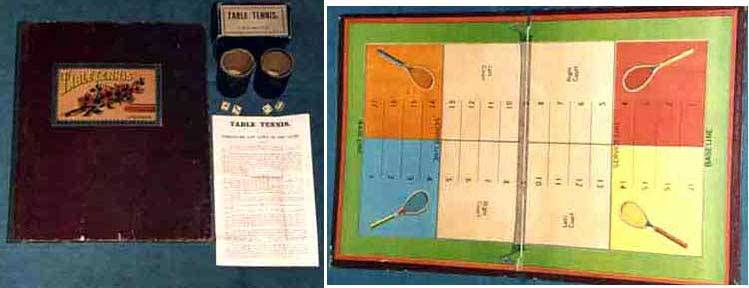
- 12th Century AD – The game of table tennis probably descended from the the game of “Royal Tennis” (also known as Real Tennis or Court Tennis), which was played in the medieval era.
- 1880’s – Some sources claim that the sport was once known as indoor tennis, and was played in the early 1880’s by British army officers stationed in India and South Africa. These officers are supposed to have used cigar box lids as paddles, rounded wine bottle corks as balls, and books for an improvised net.
- 1880’s – The game had become fashionable among the upper classes in England.
- 1887 – According to the ITTF website, the first use of the name “Table Tennis” appeared on a board and dice game made by J.H.Singer of New York.
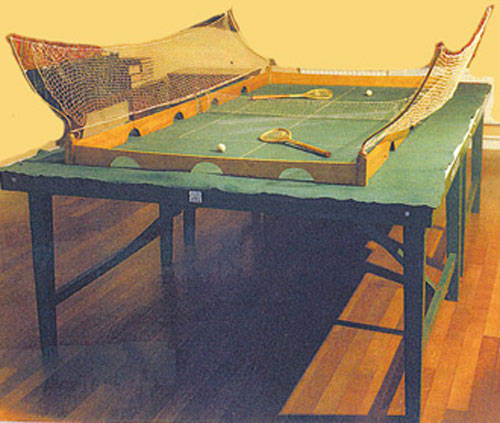
- 1890 – The earliest existing evidence of a table tennis game is a set made by David Foster, patented in England, which included table versions of Lawn Tennis, Cricket and Football.
- 1891 – John Jacques of London introduce their “Gossima” game, which used drum-type paddles, a 50mm web wrapped cork ball, and a 30cm high net.
- 1890’s – By this time, several patents with basic rules had been registered.
- 1890’s – Parker Brothers begin making an indoor tennis kit which included a portable net, a small ball covered in netting, and paddles.
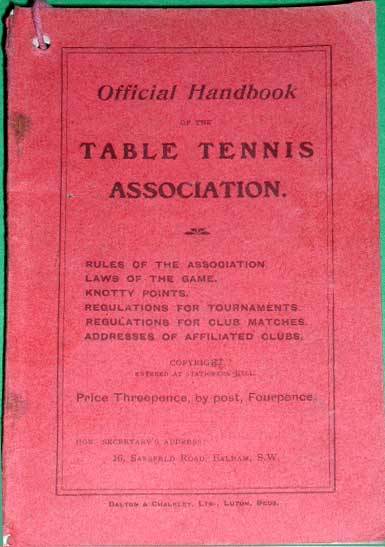
- 1900 – Englishman James Gibb is credited with bringing hollow celluloid balls back to England from the USA, although some other sources claim they were plastic balls. Previously most balls were solid rubber or cork, often covered in material. Some sources also credit Gibb with inventing the name “ping pong”, which was supposed to have been derived from the sound of the ball bouncing off the drum battledores (paddles), each of which had a different sound.
- 1901 – John Jacques register “Ping Pong” as a trade name in England. The American rights to the name are sold to Parker Brothers.
- 1901 – On the 12th December 1901, “The Table Tennis Association” is formed in England. Four days later, “The Ping Pong Association” is also formed in England.
- 1901 – Table tennis is first brought to China via western settlements. (Guide note – Thanks guys – now look what you’ve done!)
- 1902 – Englishman E.C.Goode is credited with putting pebbled rubber on his wooden blade, allowing him to put more spin on the ball. This is the forerunner of the ordinary pimpled rubber racket, which will dominate table tennis until 1952.
- 1903 – On the 1st May 1903, “The Table Tennis Association” and “The Ping Pong Association” amalgamate, forming “The United Table Tennis and Ping Pong Association”. This association will later revert its name to “The Table Tennis Association”, before becoming defunct in 1904.
Classic Hard Bat Era
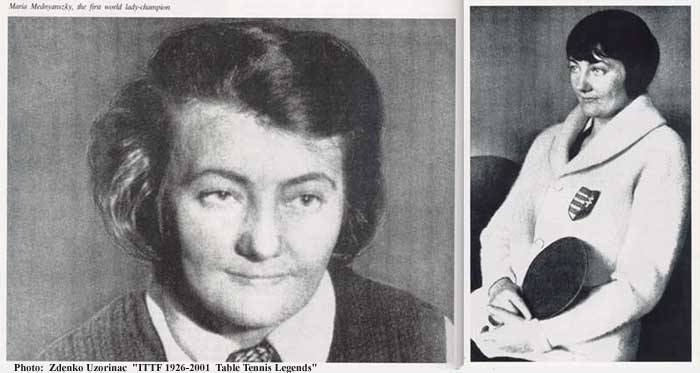
1920’s – 1950’s – Classic Hard Bat Era – Europe Dominates the Sport
- 1920’s – In the early 1920’s the game began to revive in England and Europe.
- 1922 – “The Table Tennis Association” is reconstituted, with the name “English Table Tennis Association” being adopted in 1927.
- 1926 – The International Table Tennis Federation is formed.
- 1926-1931 – Maria Mednyanszki of Hungary wins the Women’s Singles event at the World Championships five times in a row. Mednyanszki also wins 7 Women’s Doubles titles (1928-1934) and 6 Mixed Doubles titles (1926, 1928, 1930-1931, 1933-1934).
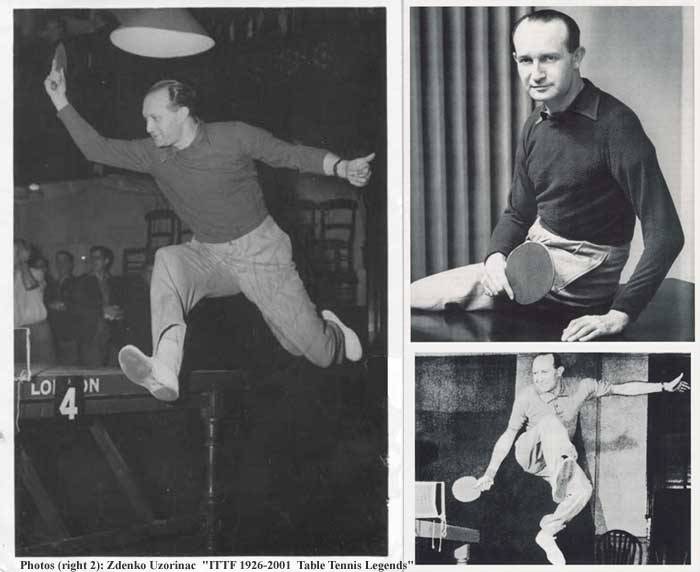
- 1930-1935 – Victor Barna of Hungary wins five of the six Men’s Singles events at the World Championships (and was runner up in 1931).
- 1935 – The American Ping Pong Association, US Amateur Table Tennis Association, and National Table Tennis Association merge to form the US Table Tennis Association (which was renamed USA Table Tennis in 1994).
- 1936 – Repainted tables (which made the playing surface very slow) and a high net (6¾ inches high) combine to make attacking play very difficult at the World Championships in Prague, Czechoslovakia. This results in the longest rally ever in a World Championships taking place, lasting over two hours.
- 1938 – The ITTF lowers the net from 6¾ inches to 6 inches, and bans the fingerspin serves which had been used with devasting effect by American players.
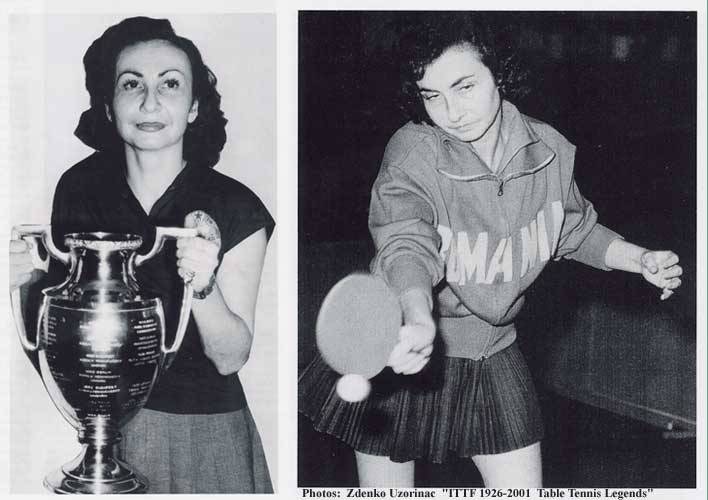
- 1940-1946 – No World Championships held due to World War II.
- 1950-1955 Angelica Rozeanu-Adelstein of Romania wins six Women’s Singles titles in a row at the World Championships. Since her last title win in 1955, every World Champion in Women’s Singles has been an Asian player. Rozeanu-Adelstein also won 3 Women’s Doubles titles (1953, 1955-1956) and 3 Mixed Doubles titles (1951-1953).
Sponge Bat Era
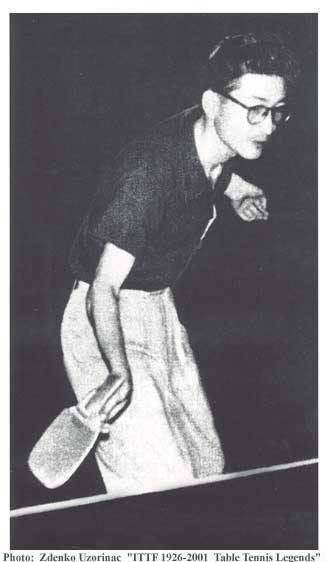
1950’s – 1970’s – Sponge Bat Era, Rise of Japan and China
- 1952 – Hiroji Satoh of Japan becomes notorious for his use of a wooden racket covered in thick foam sponge rubber, which produces much more speed and spin than conventional pimpled rubber rackets. He wins the 1952 World Championships over Jozsef Koczian of Hungary, and begins a period of Asian male domination in the sport which will last until Sweden rises to supremacy from 1989 into the early 1990’s.
- 1957 – The World Championships changes to a biennial event (once every two years), due to the logistics of hosting an event of such size, and difficulty in finding suitable venues.
- 1958 – The first European Championships is conducted in Budapest, Hungary, and sees the USSR’s debut in international table tennis.
- 1959-1960 – The ITTF standardizes the thickness of ordinary pimpled rubber and sponge rubber.
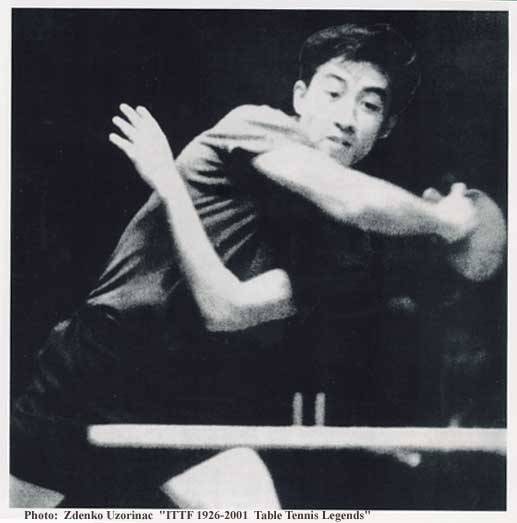
- 1960’s – In the early 1960’s, the loop drive was invented and become popular around the world.
- 1960’s – From around 1965 to 1971, China under the rule of Ma Tse-Tung disappears from world table tennis events.
- 1961-1965 – Zhuang Zedong of China wins 3 Men’s Singles titles in a row at the World Championships, each time over compatriot Li Furong.
- 1960’s – In the early 1960’s, Xhang Xi Lin of China uses a “Yin-Yan” bat with normal rubber on one side, and long pimples on the other – the first recorded instance of successful combination bat play.
- 1971 – China returns to International Competition at the 1971 World Championships.
- 1971 – The US Table Tennis Team takes a “Ping-Pong Diplomacy” trip to China, in a world first effort to use sport to establish and improve diplomatic relations.
- 1971 – Jean-Paul Weber of France uses the first anti-spin rubber in the World Championships in Nagoya, Japan, and enjoys some success with its use.
- 1971 – The first Commonwealth Championships are held in Singapore.
The Age of Speed Glue
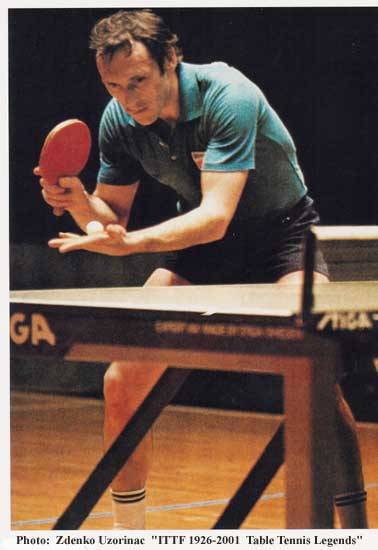
1970’s – 2000’s – the Age of Speed Glue & Technology
- 1970’s – Table tennis players discover that using bicycle tyre repair glue to put rubber on a blade dramatically increases the speed and spin that can be produced. This discovery is often credited to Dragutin Surbek of Yugoslavia, and Tibor Klampar of Hungary. This discovery is called speed glue.
- 1970’s-1989 – China is the dominant force in both men’s and women’s events on the world scene, winning multiple events at all world championships.
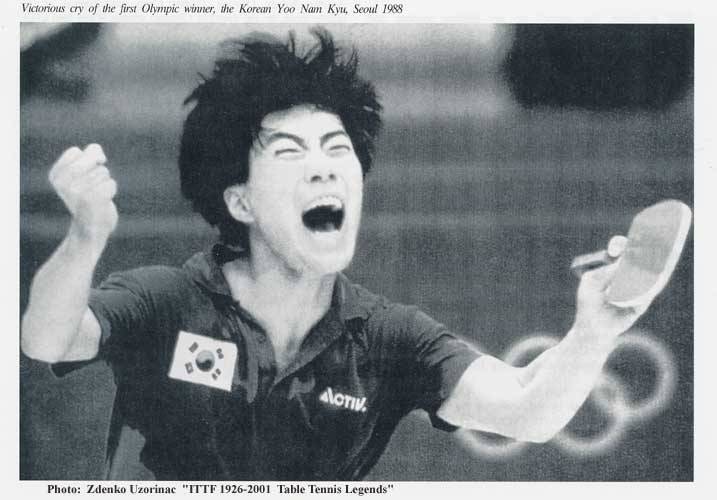
- 1980 – John Hilton of England wins the European Championships using a combination bat of normal rubber and antispin, twiddling the racket and playing aggressively.
- 1980 – The first World Cup event is held in Hong Kong.
- 1982 – The initial World Veteran’s Championships is conducted in Gothenburg, Sweden.
- 1980’s – In 1985, the two color rule is adopted to reduce the effectiveness of combination rackets.
- 1988 – Table Tennis becomes an Olympic sport, in Seoul, South Korea. The host nation’s Yoo Nam Kyu wins the Men’s Singles, and China’s Chen Jing wins the Women’s Singles.
- 1989-1993 – Sweden breaks the Chinese stranglehold in Men’s World Championships, winning the 1989, 1991, and 1993 Teams Events, and producing the 1989 and 1991 World Men’s Champions (Jan-Ove Waldner and Jorgen Persson respectively). China continues its dominance in female ranks.
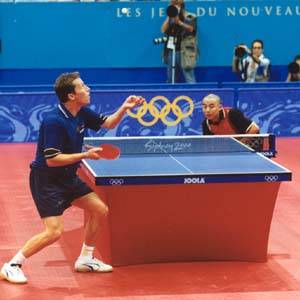
- 1995-present – China reasserts its control over the Mens Team and Mens Singles events at the World Championships.
- 1997 – Jan-Ove Waldner wins the Mens Singles title at the World Championships for the second time, this time without the loss of a single game!
- 2000 – A brief blip in the Chinese men’s dominance occurs when the aging Swedish trio of Jan-Ove Waldner, Jorgen Persson and Peter Karlsson combine to steal the Mens Team title in a thrilling final.
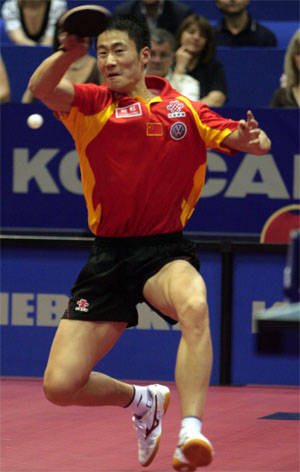
- 2000 – The ITTF increases the ball diameter to 40mm.
- 2000 – The obstruction rule changed so that the player does not obstruct the ball by intercepting it when it is moving away from the playing surface.
- 2001 – The ITTF changes the scoring system, moving to 11 point games, and using a best of 5 games or best of 7 games match.
- 2002 – Table Tennis becomes a Commonwealth Games Sport, at Manchester, England.
- 2003 – Werner Schlager of Austria breaks the Chinese stranglehold on the Men’s Singles World Championship title, saving several match points along the way against opponents in Wang Liqin and Kong Linghui. He meets Joo Se Hyuk of South Korea in the final – Joo is the first defensive player to make the Mens Singles final since Eberhard Scholer of Germany in 1969 (Scholer also lost in his final, to Japan’s Shigeo Itoh).
- 2003 – Hidden serves banned.
- 2000’s – In the early 2000’s, frictionless long pimples become popular among many players, in an attempt to negate the the power and spin produced by modern technology and speed glue.
- 2006 – The intended banning of frictionless long pips and speed glues with toxic organic solvents is announced by the ITTF.
The End of Speed Glue, The Beginning of Boosting
- 2007 – The ITTF withdraws its approval of all table tennis glues, following a health incident involving a speed glue user in Japan.
- 2008 – The use of speed glues with illegal VOCs is banned for all ITTF junior competitions as of January 1. Machines that test for illegal VOCs are introduced to check for rules infractions.
- 2008 – The use of all speed glues and boosters is banned for all ITTF competitions (the racket covering must be used without any physical, chemical or other treatment which would change its characteristics). The ITTF argues that it is for health reasons, but dissenters point out that manufacturers now have speed glues that are VOC free. The dissenters believe that it is an excuse to allow the ITTF to try to slow down the sport in a manner similar to the ball size increase of 2000.
- 2008 – Professional players shift from speed gluing to boosting. To date, the ITTF are unable to devise tests to reliably detect boosted rubbers.
Plastic Ball Era
- 2010 – The Singapore Women’s Team breaks through the Chinese wall to win the World Teams Championship in Moscow.
- 2010 – The double hit rule is reworded so that no point is now scored for an accidental double hit.
- 2013/14 – The ITTF announces that celluloid balls will be phased out in favour of plastic balls. Many reasons are put forward by the ITTF for this, but further investigation by players finds the supporting evidence to be sketchy at best.
- 2013/14 – The first batch of plastic balls hit the market. They are universally derided by players as being too different to the celluloid ball in play, with issues of softness, roundness and a tendency to break easily.
- 2014 – The technical specifications for plastic balls are changed to be different from the old rules. Now the new plastic balls must have a minimum diameter of 40mm. Under the old specifications the average ball diameter was around 39.6mm. Players again claim that the ITTF made the change to help slow down the sport.
- 2016 – Plastic balls used at the World Championships and Olympics for the first time.
- 2016 – The second version of plastic balls arrives – these are of better quality in terms of bounce and durability, and play much closer in characteristics to the celluloid ball.
- 2016 – TTX – a new form of table tennis, arrives on the scene.

